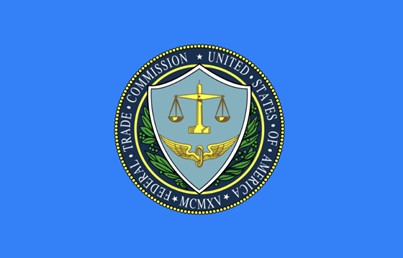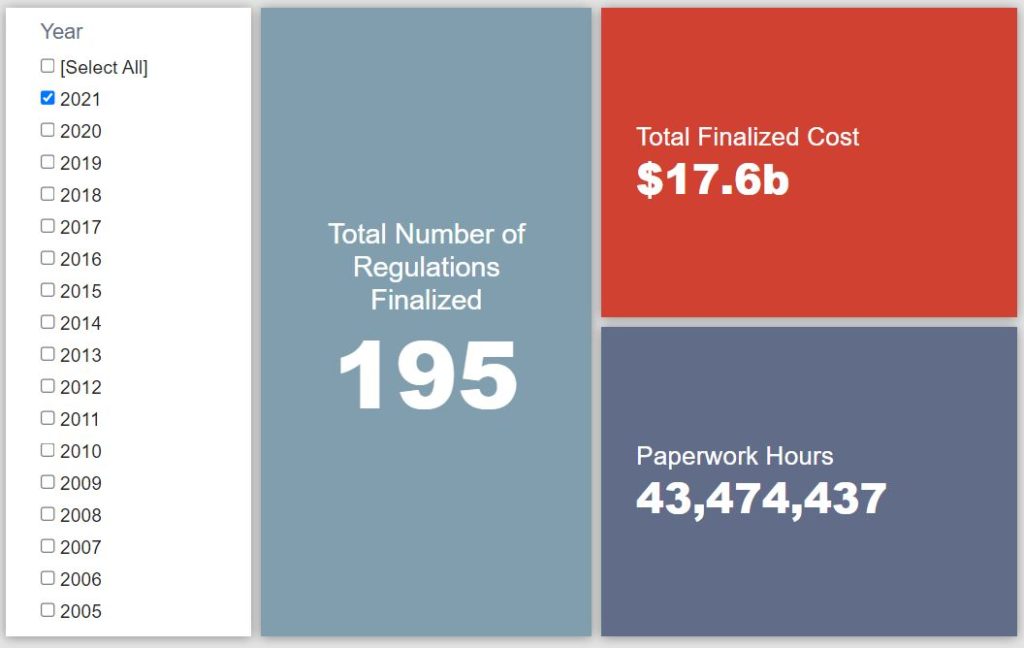Week in Regulation
September 20, 2021
Cross-Cutting Proposals Net Out to Modest Week
While there were 14 rulemakings with some kind of quantified economic impact last week, even combined they did not amount to a major cost increase. This is largely due to the two most significant actions moving in different directions: one cost-cutting, the other cost-adding. The former was an update to reporting procedures for retirement plan disclosures, while the latter focused on proposed changes to transparency requirements for air ambulance services. Across all rulemakings, agencies published $44.8 million in total net costs and added 413,905 paperwork burden hours.
REGULATORY TOPLINES
- Proposed Rules: 46
- Final Rules: 59
- 2021 Total Pages: 51,981
- 2021 Final Rule Costs: $17.6 billion
- 2021 Proposed Rule Costs: $177 billion
NOTABLE REGULATORY ACTIONS
Earlier last week, the Department of Labor (DOL) released an proposed rule entitled “Annual Reporting and Disclosure.” In particular, the proposal seeks to amend the “regulations relating to annual reporting requirements under Title I of the Employee Retirement Income Security Act” for “Form 5500.” DOL estimates that, due to these changes, reporting costs “would on average decrease under these proposed regulations relative to the current regime,” by roughly $64.6 million. In a related proposed rule that encompasses the paperwork requirements of multiple agencies, there is a decrease in annual paperwork of roughly 71,500 hours.
On the cost-adding side, there was the joint proposed rule from a handful of agencies regarding “Requirements Related to Air Ambulance Services, Agent and Broker Disclosures, and Provider Enforcement.” The proposal seeks to implement provisions of the No Surprises Act that would require greater transparency from health plans and providers to patients on the costs and financing of the use of air ambulances. While a component of the proposal’s cost analysis includes federal government costs “to build and maintain IT systems to receive, store, and analyze agent and broker compensation data and air ambulance data,” the aspects of costs that apply to private actors comes out to nearly $81 million in total, or roughly $20 million annually.
TRACKING THE ADMINISTRATIONS
As we have already seen from executive orders and memos, the Biden Administration will surely provide plenty of contrasts with the Trump Administration on the regulatory front. And while there is a general expectation that the new administration will seek to broadly restore Obama-esque regulatory actions, there will also be areas where it charts its own course. Since the AAF RegRodeo data extend back to 2005, it is possible to provide weekly updates on how the top-level trends of President Biden’s regulatory record track with those of his two most recent predecessors. The following table provides the cumulative totals of final rules containing some quantified economic impact from each administration through this point in their respective terms.
![]()
This was once again a week in which final rules took a back seat to proposed rules. Thus, there was limited change in the Biden’s Administration’s total. The Trump Administration saw its tallies tick downward modestly due mostly to a Consumer Financial Protection Bureau rule that cut $60 million in costs and 900,000 hours of annual paperwork. The largest shift, however, came from the Obama era. A Department of Homeland Security rule regarding “Air Cargo Screening” was the main reason for a nearly $2.2 billion spike in costs back in September 2009.
THIS WEEK’S REGULATORY PICTURE
This week, the Federal Trade Commission (FTC) withdraws its approval of guidelines on vertical mergers.

On September 15, the FTC voted in a 3-2 decision to withdraw its approval of guidelines issued last year on how to consider vertical mergers. Vertical mergers are those that combine firms or assets at different stages of the same supply chain. The 2020 guidelines, which were jointly issued by the FTC and the Department of Justice (DOJ) since they share enforcement authority over mergers and acquisitions, spelled out a shared framework for how the agencies will exercise analytical techniques, practices, and enforcement policies when it comes to vertical mergers.
The split vote fell along party lines. The three Democrats on the FTC, led by Chair Lina Khan, issued a statement explaining their decision to withdraw the FTC’s approval that criticized certain parts of the guidelines, particularly the section that emphasized that vertical mergers can have procompetitive effects by reducing costs for firms that would then be passed along to customers in the form of lower prices. The majority stated that they felt there was no statutory basis for analyzing how mergers may improve economic efficiency and asserted that such efficiency improvements are not reflected in reality.
In a dissenting statement, the two Republican commissioners challenged the majority’s assertion by citing examples of beneficial vertical mergers, while noting that there are instances where such mergers can be harmful to consumers – instances which the 2020 guidelines were designed to address. The minority also criticized the decision of the majority to withdraw its approval of the guidelines without providing meaningful notice and seeking public comment on the matter. It also noted the obvious uncertainty the withdrawal created since the DOJ is still operating under the guidelines, and the FTC has not offered a replacement.
For its part, the DOJ issued a statement that it is still reviewing the 2020 guidelines and intends to work with the FTC on amending them. In the meantime, the FTC’s decision to withdraw its approval of the guidelines is likely to result in confusion and uneven scrutiny of merger reviews.
TOTAL BURDENS
Since January 1, the federal government has published $194.6 billion in total net costs (with $17.6 billion in new costs from finalized rules) and 45.4 million hours of net annual paperwork burden increases (with 43.5 million hours in increases from final rules).












